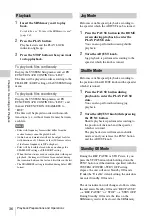
SR Motion
49
Ch
apt
er 4
Re
co
rdin
g and Pl
ay
bac
k
REMOTE DUB mode
• “REMOTE DUB” appears in the status
indication of the HOME screen.
• Operations are identical to that of SDI INGEST
mode.
• When the SYNC PLAY command is received
from REMOTE IN while REMOTE DUB is
selected and the PLAY LOCK state is enabled,
the REC command is included in the SDI OUT
signal, regardless of the SDI REMOTE OUT
setting. When the REC command is included,
the “REMOTE DUB” indicator appears red.
• Connect an RS-422 controller, such as the
RM-280, that supports SYNC PLAY to
REMOTE IN, and enable the SDI REMOTE IN
setting for the recorder on the input side.
• To send SYNC PLAY commands from the
control panel, press the PLAY button while
holding down the BACK button.
• To perform normal playback without DUB,
change the settings for the PLAY button and
other buttons required for playback from “DIS”
to “ENA” (enable) under KEY MAP of the
SYSTEM Setup menu.
To return to normal mode
Set “SDI INGEST” to “OFF” and confirm
t
select and confirm “SET.”
The system reboots automatically, and starts in
normal mode.
SR Motion is a function that allows you to obtain
slow and quick motion effects by setting different
values for the number of frames at shooting time
and the number of frames in the recoded material
(number of frames at playback time and target
frame frequency). You can check (review) the
motion effects immediately after shooting. Since
only the required number of frames is recorded,
no format conversion is needed.
SR Motion has the following functions.
1) This is only supported when PMW-F3 is connected.
Notes
• Audio is not recorded with SR Motion.
• SR Motion cannot synchronize two or more recorders,
even if TCG MODE is set to “Regen”.
• When using the SR Motion function, be sure to check
the version of the PMW-F3 that will be connected to
the unit. For details on versions, contact a Sony service
representative.
For details on format settings during connection to the
PMW-F3, see “Using the Select FPS function”
(page 56).
What is the target frame frequency?
Normally, the frame frequency of recorded
material is determined before shooting (for
example, it is usually set to 24 Hz for movies, and
29.97 Hz or 25 Hz for TV programming) and then
the recorded material is played back at that frame
frequency after shooting. In SR Motion, the pre-
determined number of frames of recorded
material per second is called the “target frame
frequency.”
SR Motion enables motion effects to be achieved
by appropriately setting three variables: the
“target frame frequency,” the “system frequency”
at shooting time, and the “number of frames shot”
at shooting time.
SR Motion
Function
Features
Reference
Select FPS
1)
Provides smooth slow
and quick motion
effects without skipped
frames.
















































